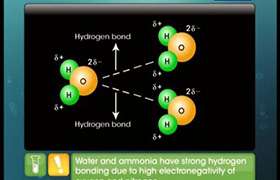CBSE Class 11-science Answered
what does the dipole moments permanent dipole moment and temporary dipole moment indicate please explain their significance in detail with an example
Asked by damarlasumanjali | 27 Oct, 2014, 08:35: AM
Dear damarlasumanjali@gmail.com
Thanks for asking us a question in Ask the Expert section of TopperLearning.com.
A permanent dipole is when you have a polar molecule with oppositely charged ends, and these ends attract other polar molecules, bonding them together. The polar molecules will always be slightly negative on one end and slightly positive on the other. The slightly negative attracts the slightly positive on another molecule, and the slightly positive attracts the slightly negative on another molecule. Therefore, they bond together. (Permanent dipoles are found in the dipole-dipole forces.) Example H2O and NH3 have permanent dipole moment. Permanent dipoles form when the structure of the molecule is such that there is an asymmetry of electronegativity amongst atoms bonded to a central atom. For example, CH4 is nonpolar but CH3F is polar because F has a higher EN than the three other H's bound to the central atom). Lone pairs on the central atom (such as in H2O and NH3) also lead to permanent polarity.
Regards
Topperlearning Team.
Answered by Prachi Sawant | 27 Oct, 2014, 10:39: AM
Concept Videos
CBSE 11-science - Chemistry
Asked by neerudhawanbpsmv | 28 Jun, 2021, 09:22: AM
CBSE 11-science - Chemistry
Asked by swatipuspapatel | 10 Jun, 2020, 06:19: PM
CBSE 11-science - Chemistry
Asked by vanyashree106 | 13 Dec, 2019, 09:38: PM
CBSE 11-science - Chemistry
Asked by Asif.k1992 | 12 Sep, 2019, 02:41: PM
CBSE 11-science - Chemistry
Asked by ajitbhot73 | 25 Aug, 2019, 11:52: AM
CBSE 11-science - Chemistry
Asked by design1.bharatifire | 21 Jun, 2019, 06:35: PM
CBSE 11-science - Chemistry
Asked by anitabahuguna | 04 May, 2019, 09:57: PM
CBSE 11-science - Chemistry
Asked by Jatinaa786 | 19 Sep, 2018, 02:53: AM
CBSE 11-science - Chemistry
Asked by arjunshrivastav668 | 17 Mar, 2018, 10:21: AM
CBSE 11-science - Chemistry
Asked by Topperlearning User | 04 Jun, 2014, 01:23: PM




